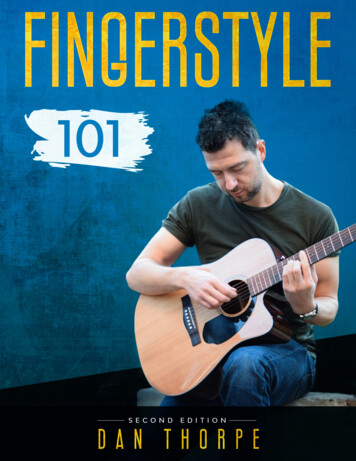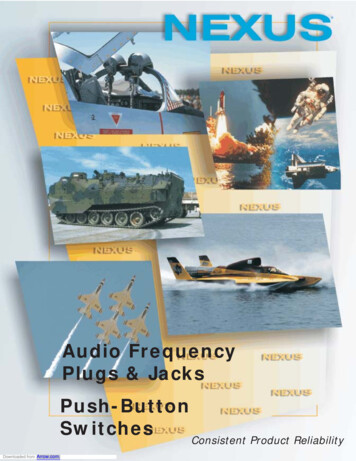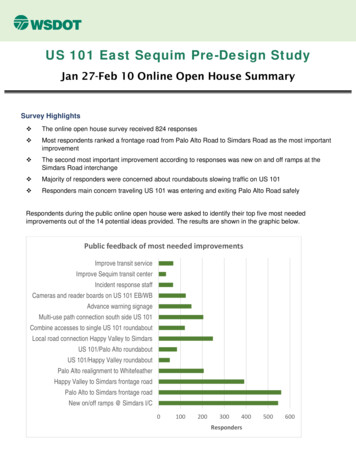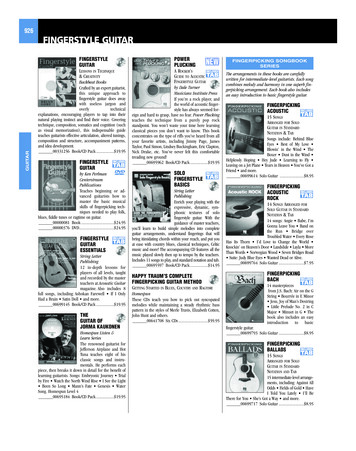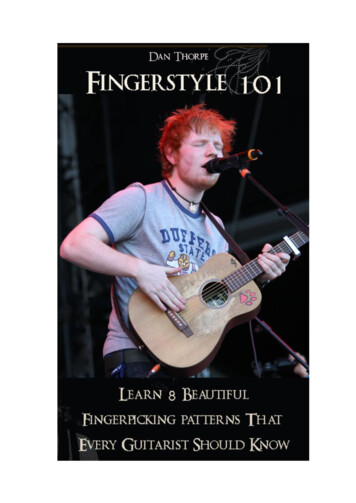
Transcription
Copyright 2015All rights reserved. No part of this book may be editedwithout the prior written permission of the publisher. You arefree to distribute it in its current, exact form.DisclaimerAll the material contained in this book is provided foreducational and informational purposes only. Noresponsibility can be taken for any results or outcomesresulting from the use of this material.While every attempt has been made to provide informationthat is both accurate and effective, the author does notassume any responsibility for the accuracy or use/misuse ofthis information.Free BonusesGo to Guitardomination.net/fingerstyle-101-free-bonus to getyour exclusive free bonus content for this book.ReviewsIf you enjoy this book, please head over to Amazon andleave it a review. I ll be forever grateful and will even buyyou a drink if we ever meet in person!
Table of ContentsIntroduction . 4About the book . 6Terminology . 8How to listen to and learn the patterns .15The Essential Chords .21The Importance of the Thumb and root notes .27The Patterns .31#1 The “Going Up” Pattern.32#2 The “Ballad” Pattern .40#3 The “Outside-In” Pattern .47#4 The “London” Pattern .57#5 The “Romanza” Pattern .66#6 The “Ed Stream” Pattern .76#7 The “Butler” Pattern .84#8 The “Sweet Melody” Pattern .93Where to next? . 1036 Steps To Getting The Most Out Of This Book (andYourself) . 104Chord Reference Guide . 116Links and Other Useful Resources . 126
IntroductionThere aren’t many better sounds in the world than aguitar being fingerpicked.It could be a battered old Takamine, a brand spankingnew Fender electro acoustic or a boutique Ramireznylon classical.It doesn t matter what guitar you have, withfingerpicking you can take the most simple of chordsand turn them into elegant, joyous, awe-inspiringpieces of music that will stun and delight youraudience.Fingerpicking the guitar can and will bring youmany years and decades of fun, joy andexpression to your life.You will enrich your own life and those of othersaround you.You can even charm your loved ones with somestunning fingerstyle guitar.Public Health WarningBeware though, once you have mastered these 8patterns and if you play them in public, people will be4Go to http://guitardomination.net for more free articles andguitar resources
finding you irresistible and you may find that you getlots of drinks bought you by random people!Fingerstyle guitar is not new, but it has made a hugecomeback over the past few years.It actually dates back a long way.Fingerpicking guitar changed music and the worldaround it.Whenever you listen to the radio, watch a guitarist orput on your favourite guitar songs, it's very often thefingerpicking guitar parts that stand out and grab ourattention.It can be a complex pattern using syncopation in 6/8time or it can be a simple little chord melody using justthe thumb and two fingers.Either way, it's the sound that matters.Don't make the mistake of trying to be tooclever or too complex with fingerpicking.It can get very complicated very fast if you don't keepyour eyes (and ears) on the ball.Always use your ears as the sole guide of what soundsgood.5Go to http://guitardomination.net for more free articles andguitar resources
About the bookThroughout this eBook you will see 8 examples offingerstyle guitar playing.They are 8 very different patterns.This isn t a case of rehashing the same patterns.Don t worry if you play acoustic, classical orelectric guitar.All the examples will work and sound great on ANYguitar as long as it is a guitar you are comfortableplaying.The chord progressions you will learn are some of myfavourite and most beautiful patterns.Each pattern comes with two examples.The first example features the pattern played with a CMajor, G Major and a D Major chord.You are also going to learn a real world examplechord progression with each picking pattern.This is so you can actually hear the fingerpickingpatterns in use in the real world.6Go to http://guitardomination.net for more free articles andguitar resources
Once you have learnt the picking pattern and thechord progression that goes with it, experiment withplaying the fingerpicking pattern with some of yourown favourite chord progressions.Once of the beauties of fingerpicking is the possibilitieswe have opened up to us.Feel free to experiment and adapt.Some of the fingerpicking patterns and chordprogressions are inspired by the likes of:Ferdinando Carulli and Fernando Sor (classical)Paul Simon and James Taylor (classic folk)Ed Sheeran and John butler Trio (modern pop)There is a nice range and mixture of styles in this bookto suit everyone s tastes.7Go to http://guitardomination.net for more free articles andguitar resources
TerminologyTo avoid confusion throughout this book I will refer tothe fingers and strings of the guitar in a certain way.StringsThe six strings of the guitar will be described as theiropen string notes and NOT their string number.See below for which string is tuned to which note.6 Low E5 A4 D3 G2 B1 High ERemember, it s the note on the right hand side of the8Go to http://guitardomination.net for more free articles andguitar resources
above chart that we will be using throughout the book.FingersThroughout the book, I will describe the fingers ofboth the fretting and picking hands by their names andnot their numbers.ThumbIndexMiddleRingPinkyThe reason for this is, if we call everything by itsnumber, such as, if I state:“Play fret 2 with the 3rd finger on the 2nd string”It can confuse people.9Go to http://guitardomination.net for more free articles andguitar resources
Where as if I state:“Play fret 2 with the ring finger on the B string”It will have more clarity.10Go to http://guitardomination.net for more free articles andguitar resources
The rule of fingerpicking.Generally, when fingerpicking the:Thumb plays the bass strings (low E, A and D)Index finger plays G stringMiddle finger plays B stringRing finger plays high E stringFollow this rule throughout, but as you will see lateron, there are exceptions to this rule .11Go to http://guitardomination.net for more free articles andguitar resources
RhythmIt s essential for you to understand and be 100%comfortable with rhythm.It is useful if you understand the theory behindrhythm.For example, if you are able to discuss what quarternotes are, that is a bonus.It s far more important however, for you to be able tohear a rhythm and replicate it.In this book there are four main note lengths that weare going to use.12Go to http://guitardomination.net for more free articles andguitar resources
These are:Quarter note 1 whole beat – There are 4 x quarternotes per bar (in 4/4 time).Eighth note 1/2 of a beat – There are 8 x eighthnotes per bar (in 4/4 time).Triplet Eighth note 1/3 of a beat – There are 12 xtriplet eighth notes per bar (in 4/4 time).Sixteenth note 1/4 of a beat - There are 16 xsixteenth notes per bar (in 4/4 time).13Go to http://guitardomination.net for more free articles andguitar resources
There are lots of different types of rhythm out there inwestern music such as the ones stated above plusother more advanced types such as dotted rhythms.For the majority of music out there quarter, eighth andsixteenth notes cover most of the ground.All the patterns in this book use quarter, eighth,sixteenth and triplet eighth notes.These note lengths are called sub-divisions.For more help with and to hear the sub-divisions inaction, watch this video tutorial.As stated above, if you can understand what quarter,eighth, sixteenth and triplet notes are, that is fantastic,but being able to play them is much moreimportant.Always listen to the examples and get the rhythm inyour head before attempting them.14Go to http://guitardomination.net for more free articles andguitar resources
How to listen to and learn thepatternsAll eight fingerpicking patterns and their two examplescome with audio examples which you can either:Listen to by clicking each link as we go alongORDownload as part of the free bonuses for thisbookYou can then save each audio example to your mediaplayer, play them on repeat and get learning them.Each fingerpicking example also comes with a GuitarPro file so you can play them, slow them down, speedthem up, loop certain sections and adapt them if youlike.Guitar Pro isn t cheap but it is well worth the money ifyou have the resources to buy it.15Go to http://guitardomination.net for more free articles andguitar resources
You can purchase and download Guitar Pro from here.For a free alternative to Guitar Pro, I recommend TuxGuitar.Tux Guitar is free software that can play Guitar Profiles and do a lot of the things that Guitar Pro can do.You can download Tux Guitar here.16Go to http://guitardomination.net for more free articles andguitar resources
Example 1The first example for ALL the patterns is played with a:C Major ChordG Major ChordD Major ChordThere is one bar on each chord but for the firstexample it is more about learning the pattern withfamiliar shapes.Therefore, do not worry about trying to play example 1all the way through.Stay on one chord and keep repeating it until you getit right.Then move onto the next chord.I have used the chords of C, G and D because they allhave different amounts of strings played within thechord.17Go to http://guitardomination.net for more free articles andguitar resources
C Major - 5 stringsG Major - 6 StringsD Major - 4 stringsThis covers all the bases so to speak.When you learn other four, five or six stringchords, simply play the exact same pattern asyou did for the chord with the same amount ofstrings.For example, if you want to play a certain pattern inthe book with Em, ask yourself:“How many strings are in the Em chord?”Six is the answer.Therefore, you play the exact same pattern as you didfor the G Major chord as this is also a six stringchord.18Go to http://guitardomination.net for more free articles andguitar resources
Another advantage of using the same C, G and Dchords for the first example is so you can compare thesound of ALL the patterns against each other with thesame three chords.19Go to http://guitardomination.net for more free articles andguitar resources
Example 2The second example is where we get really creativeand use a whole bunch of cool ideas with your typicalopen chords such as Am, Em to B7, E7, FMaj7,Dm7 and more.Some of these examples use a variety of fretting handtechniques.Things such as using alternate bass notes forfamiliar chords and the use of melody within achord.We also incorporate a great technique that I call chord anchors .There is also the use of medieval sounding dronenotes within chords, lush Major and minor 7 chordsand more.The main feature of this book is to learn about pickinghand techniques and the eight patterns of course.You will see as we go on that a variety of frettinghand techniques can not only simplify butcompliment the picking patterns.20Go to http://guitardomination.net for more free articles andguitar resources
The Essential ChordsThe first example for each fingerpicking pattern usesthe chords of C Major, G Major and D Major as shownbelow.The blue notes for all the chord diagrams in this bookare the root notes . These, as will be explained, areessential for all fingerpicking guitarists.C Major21Go to http://guitardomination.net for more free articles andguitar resources
G MajorThere are two common versions of G Major with analternate way of fingering one of those versions.G Major (Rock Version)This version is the four finger version that has a more rocking sound.In general, this version is more suited to a strummedguitar.G Major (Folk Version)22Go to http://guitardomination.net for more free articles andguitar resources
This version is the three finger version of G manybeginners learn as it is the easiest to play for mostguitarists.G Major (Folk Alternate Version)This is exactly the same chord as the one above it but23Go to http://guitardomination.net for more free articles andguitar resources
importantly it is played with different fingers.You only use the following fingers:Middle (2nd fret A string)Ring (3rd fret low E string)Pinky (3rd fret high E string)Leave index finger free.This is done so the change to the C Major chord ismade easier (try it out now)and.So we can use the index finger to play notes on the 1stand 2nd frets while maintaining the shape of theG chord with our other fingers (more on this later).24Go to http://guitardomination.net for more free articles andguitar resources
D MajorYou will notice that the fingerpicking patterns you learnthroughout this book are slightly different for the DMajor chords.This is because the D Major chord features just fourstrings in its most typical form and we have tocompensate for this.As explained earlier on, the thumb usually plays thebass strings (low E, A and D) and the fingers play thetreble strings (G, B, and high E).When playing a typical D chord we only have onebass string in use which is the D string.Because of this we often treat the G string as abass string, but ONLY when playing D chords(and other four string chords).25Go to http://guitardomination.net for more free articles andguitar resources
This means the thumb will sometimes pick this G string pretending it is a bass string.This is very common in real world fingerpickingscenarios as you will see.26Go to http://guitardomination.net for more free articles andguitar resources
The Importance of the Thumband root notesThe patterns featured in this book all start with theroot note of the chord (being played with the thumb)at the beginning of the bar.That means if you play a C Major chord, the:First pluck with the picking hand will be with thethumb on the C note on the 3rd fret of the Astring (as this is the root note).If you play a G chord, the:First pluck with the picking hand will be with thethumb on the G note on the 3rd fret of the low Estring (as this is the root note).If you play a D chord, the:First pluck with the picking hand will be with the27Go to http://guitardomination.net for more free articles andguitar resources
thumb on the D note of the open D (as this is theroot note).Learn and master your root notes for theseessential chords and all the other chords you know.It is really important when fingerpicking.28Go to http://guitardomination.net for more free articles andguitar resources
Why are root notes soimportant?The root note is the strongest note within a chordand the listener is used to hearing this being played atthe beginning of a new chord change.There are of course, exceptions to this but most of thetime, keep it simple and start the bar off with the rootnote - your music will sound stronger for it.You will notice that the root notes for different chordsare located on different strings.This means your thumb will be changing betweenthe low E, A, D (and sometimes the G, but more onthat later) strings.29Go to http://guitardomination.net for more free articles andguitar resources
Don t forget to hold your chord shapesWhenever you look at the tab or musical notation,ensure you look at the chord shape notated above it.The above example has a C, G and D chord.At the beginning of each bar, make sure you play theshape of the chord stated with the fretting hand andthen hold that shape throughout until you seethe next chord shape.We want as many notes to ring fluently throughoutthe piece as possible.30Go to http://guitardomination.net for more free articles andguitar resources
The PatternsRight, now we have covered the basics of chords, rootnotes and terminology, let s have some fun and learnthe eight fingerpicking patterns.For every example in the book, I have detailed adescription of what I believe is the easiest way to playthem.Please note: You may want to play some of the piecesslightly differently to me and that is perfectly ok. Mydescription is simply a guide.31Go to http://guitardomination.net for more free articles andguitar resources
#1 The “Going Up” PatternClick here to watch the video lessonOur first fingerpicking pattern is a simple 6/8fingerpicking pattern that you have no doubt heard inmany ballad type songs.It is called the “Going Up” pattern as we go up thestrings one at a time, before briefly coming back down.Don t be worried or concerned about 6/8 time.There are 6 eighth notes in 6/8 time.Most guitarists count these as 1, 2, 3, 1, 2, 3The two sets of 3 equal 6 (which are the 6 x eighthnotes).Play each 1 with a slight accent (hit a touch harder)and play the 2, 3 a touch quieter.This creates the distinctive sound of 6/8.Listen to and then play the following pattern.32Go to http://guitardomination.net for more free articles andguitar resources
The “Going Up” PatternClick here to listen to the exampleUse the thumb to play the root note of each chord atthe beginning of each bar.Then use the:Index finger (G string)Middle finger (B string)Ring finger (high E string)Middle finger (B string)Index finger (G string)6/8 is a common time signature that you have nodoubt heard in lots of big hits.One of the most popular of these is R.E.M. s huge hit“Everybody Hurts”.If you take this pattern and play it with a D and then33Go to http://guitardomination.net for more free articles andguitar resources
the rock version of G Major for two bars on each chordthen you have the main bulk of that classic song.34Go to http://guitardomination.net for more free articles andguitar resources
C Major (and other 5 string chords)On the C Major chord the initial bass pluck is on the 3rdfret of the A string (as this is our root note for the Cchord).We then play the strings of G (with index finger), B(with middle finger) and high E (with ring finger)before going back to the B and G strings.The rest of the pattern is the same for everychord. Only the initial root note string variesfrom chord to chord.G Major (and other 6 string chords)On the G Major chord the initial bass pluck is the low Estring at the 3rd fret (as this is our root note for the Gchord).D Major (and other 4 string chords)On the D Major chord the initial bass pluck is the openD string (as this is our root note for the D chord).35Go to http://guitardomination.net for more free articles andguitar resources
The “Going Up” Pattern ExampleClick here to listen to the exampleThe above example is a simple chord progressionbased around the key of G Major with a quick chordsubstitution in the penultimate bar before going backto the key of G Major.The first three bars act as an intro.36Go to http://guitardomination.net for more free articles andguitar resources
Notice how the G note on fret 3 of the high E stringdescends down the fretboard one fret at a time.It moves from the 3rd fret, to the 2nd fret to the1st fret.This is called a chromatic run and adds a touch of jazzto the piece.When playing this initial G, GMaj7, G7:It is best to start the first G off using the folkalternate version (refer to the chord chart at thebeginning of the book).The reason I recommend doing this is, it allows us toplay all three chords G, GMaj7, G7 without switchingshapes.With your fretting hand, you can play the:3rd fret on the high E string with your pinky2nd fret with your index finger1st fret with your index finger.for the G, GMaj7, G7.37Go to http://guitardomination.net for more free articles andguitar resources
You do all this while holding your middle andring fingers in the same place throughout.You may not have played a G chord like this before.It is very common though - especially withfingerpickers.Take it nice and slow and focus on perfecting the intro(the first three bars) first before tackling the rest of thepiece.Although a simple picking pattern, it sounds lovely andis one you should add to your repertoire of patterns.Whenever someone mentions playing in 6/8 time youcan use this pattern to show them just how good youare.38Go to http://guitardomination.net for more free articles andguitar resources
Key TakeawayYou will notice with fingerstyle guitar, you willsometimes have to fret chords in a different manner tohow you have done so in the past.The main reason for this is to allow melody notes to beplayed alongside the chords that wouldn t be possibleotherwise.Being adaptable with your chord shapes is keyto being a successful fingerpicker.39Go to http://guitardomination.net for more free articles andguitar resources
#2 The “Ballad” PatternClick here to watch the video lessonThe “Ballad” pattern is a simple fingerpicking pattern in4/4 time.Although it is quite basic it has a powerful quality thatoverrides its simplicity.40Go to http://guitardomination.net for more free articles andguitar resources
The “Ballad” PatternClick here to listen to the exampleTo play the pattern we start with a pinch .The Pinch A pinch is when we play two notes together – one bassand one treble note.In this instance we pinch the root note (withthumb) and the high E string (with the ring finger)together.This pinch is played as a quarter note.41Go to http://guitardomination.net for more free articles andguitar resources
The patternOnce you have played the pinch, the following twonotes are played as eighth notes.Play the:G string (with your index finger)Followed by the B string (with your middlefinger)That is half a bar completed.Notice how the rest of the bar is simply this samepattern of pinch, G string, B string repeated.42Go to http://guitardomination.net for more free articles andguitar resources
The “Ballad” Pattern ExampleClick here to listen to the example43Go to http://guitardomination.net for more free articles andguitar resources
For the above example we move away from standardchord shapes and play some alternate chordshapes.What we are doing here with our fretting hand iskeeping our:Ring finger on the 9th fret of the G stringPinky on the 9th fret B stringWe do this all throughout the piece.The index and middle fingers play a variety ofnotes around these two anchored notes to createthe harmony and melody.Notice how, for the first four bars the only notes thatchange is the bass note on the low E string.The order of the bass notes on the low E string areplayed:As an open string7th fret (with index finger)9th fret (with middle finger)8th fret (again with middle finger)In bars five and six, notice how the bass note stays onthe low E string, while we change the note on the highE string.44Go to http://guitardomination.net for more free articles andguitar resources
For the part when you play the 9th fret of the high Estring, you will either have to:Shuffle your fingers around away from the anchors temporarilyOrPlay a little barre across the top three stringswith the ring finger before moving back to the anchored position.Watch the video to see how I do it.Don t forget to keep your fretting hand ring andmiddle fingers stationary on fret 9 throughout wherepossible.This is an interesting piece that has an ethereal qualityto it and one that is inspired by the drone basedmedieval lute music popular in England during themiddle ages.45Go to http://guitardomination.net for more free articles andguitar resources
Key TakeawayA simple fingerpicking pattern can sounddrastically different when played with a bunchof alternate chords. Chord anchors are very powerful for testing outpicking hand ideas as you do not have to focus quiteas much on the fretting hand.This frees you up to try out and experiment with thepicking hand.Of course, you can try this ballad pattern with a morestandard chord progression such as G, Em, C, D andhear how different it sounds.46Go to http://guitardomination.net for more free articles andguitar resources
#3 The “Outside-In” PatternClick here to watch the video lessonLet s look at our first Travis picking pattern. Travis picking is a method of playing different bassnotes with the thumb and interspersing them withthe higher strings.Look at the example below to see what I mean.It is an eight note to the bar pattern with the firstfour plucks the same as the last four plucks.This allows us to keep things simple.47Go to http://guitardomination.net for more free articles andguitar resources
The “Outside-In” PatternClick here to listen to the exampleA Travis pattern is picked:Thumb (on the root string)A Finger (on one of the treble strings)Thumb (alternate bass string)A Finger (on one of the treble strings)This pattern is called the “Outside-In” pattern and isa common pattern amongst fingerstyle guitarists.It is called the “Outside-In” pattern because we starton outside strings and work our way into the middlestrings of the chord.48Go to http://guitardomination.net for more free articles andguitar resources
The PatternPlay the first bass note on the root of the chord.Then play the:B string (with the middle finger)A bass note on the D string (with the thumb)G string (with index finger)Repeat all of the above to complete the bar.49Go to http://guitardomination.net for more free articles andguitar resources
The D chord – the exception to the ruleNotice how (as described earlier) we often treat the Dchord and (other four string chords) differently.The whole picking pattern is the same as the C Majorchord but is shifted up a string.We can even use the same fingers to pick the Dchord as the C chord.Compare the patterns above for the C and D chordsand see how it s exactly the same apart fromeverything on the D chord is played one string abovethat of the C chord.Why?Because a D chord only has one bass note which is theD string (in its most common form) so we treat the Gstring as a bass note in this instance.This means however, we need to shift everything elseup a string.Keep practicing the above pattern on all three chords.50Go to http://guitardomination.net for more free articles andguitar resources
C Major (and other 5 string chords)On the C Major chord the initial bass pluck is the Astring on the 3rd fret (as this is our root note for the Cchord).Our second bass note is the string above which is onthe D string.G Major (and other 6 string chords)On the G Major chord the initial bass pluck is the low Estring on the 3rd fret (as this is our root note for the Gchord).Our second bass note is on the D string.(You can of course play your alternate bass note onthe A string, but for this example it sounds smootherand more consistent playing the same alternate bassnote for the G chord as we did for the C chord)D Major (and other 4 string chords)On the D Major chord the initial bass pluck is the Dstring (as this our root note for the D chord).51Go to http://guitardomination.net for more free articles andguitar resources
Our second bass note is the string above which is theG string.Note: The G string is technically not a bass note, butto continue following the pattern when playing any Dchord we can treat the G string as a bass string.52Go to http://guitardomination.net for more free articles andguitar resources
The “Outside-In” Pattern ExampleClick here to listen to the exampleThe above real world example is heavily influencedby the 60 s and 70 s folk fingerpickers such as PaulSimon and James Taylor.For this example, I have kept it simple and kept eachchord as a 5 string chord.This means you pick all the same strings for eachchord shape throughout.This is useful because it allows you not to worry toomuch about changing bass notes throughout with thepicking hand.53Go to http://guitardomination.net for more free articles andguitar resources
There are four chord shapes used throughout.CG/BAmAsus2Play it through and notice at the end of the piece youplay a little strum on the Am chord.Use a finger or your thumb to strum this chord as youwould do when strumming normally.This strum is simply there to add a little more interestto the piece.You can of course use this fingerpicking pattern all theway throughout a song.Once you have played the little strum on the A minorchord, the whole piece repeats as shown by the twodots at the end of the notation.The very last Am chord at the end of the piece inbrackets is to indicate a tied note which simply meansthe previously strummed Am chord is to ring out.54Go to http://guitardomination.net for more free articles andguitar resources
As with all these examples, watch and listen closely tothe audio or use the Guitar Pro file for clarity.55Go to http://guitardomination.net for more free articles andguitar resources
Key Takeaway Travis picking is one of the most commonfingerstyle techniques ever.You will hear this everywhere especially when listeningto more traditional fingerstyle players such as PaulSimon and Merle Travis (the guitarist the techniquewas named after).Be comfortable with the idea and process ofalternating the bass notes with the thumb on eachbeat.If you need to, practice leaving out the melody noteson the treble strings just to practice changing betweenbass notes comfortably on their own before adding themelody notes back in.56Go to http://guitardomination.net for more free articles andguitar resources
#4 The “London” PatternClick here to watch the vide
To avoid confusion throughout this book I will refer to the fingers and strings of the guitar in a certain way. Strings The six strings of the guitar will be described as their open string notes and NOT their string number. See below for which string is tuned to which note. 6 Low E 5 A 4 D 3 G 2 B 1 High E


